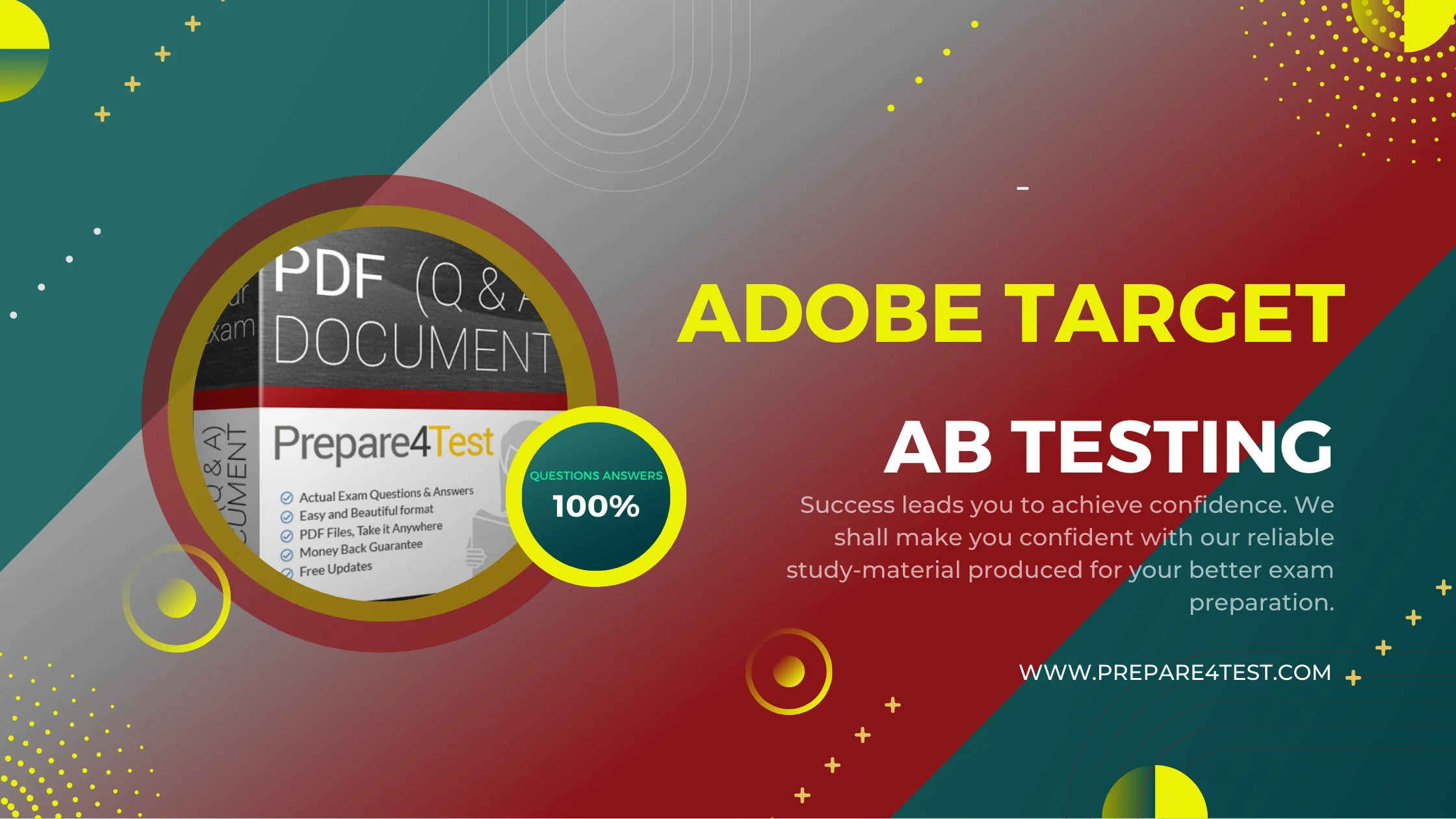
Adobe Target AB testing is a critical part of any digital optimization strategy. It allows you to test different versions of an experience to determine which one best meets your goals. With Adobe Target’s visual editor, setting up A/B tests is simple, even for non-technical users.
The purpose of Adobe Target AB testing is usually to identify the best performing variant in terms of conversion, revenue, or engagement. This could be changing the background color of a button, testing different headlines, or even offering personalized product recommendations. Adobe Target makes it easy to test experiences across web, mobile apps, and more.
To set up an effective test, first identify your goals and key performance indicators (KPIs). What action do you want site visitors to take? Common goals are increasing registrations, downloads, purchases, or time on site. Tracking custom events is also possible.
Next, use Adobe Target’s visual editor to build the different experiences you want to test. The platform offers an intuitive WYSIWYG editor for quickly changing page elements like images, headlines, calls-to-action, and layouts. More advanced users can modify the underlying HTML/CSS.
Once your experiences are built, configure the test settings like audience targeting, traffic allocation, and duration. Use the platform’s reporting to monitor performance and automatically transition visitors to the winning variation over time. Rigorous testing is key to optimizing digital experiences and achieving business goals.
Definition of Adobe Target AB Testing
Adobe Test and Target is an optimization platform that allows you to easily set up A/B tests to improve your website and mobile app experiences. The purpose of A/B testing with Adobe Target is to test two or more variants of a page or component like a button or image to determine which one better achieves your goals and business objectives. Common goals are increasing conversions, revenue, engagement and more. Adobe Target makes it simple to build A/B tests using its visual editor to modify elements like copy, layouts and images. Robust statistical methodology ensures winning experiences are accurately identified over time. Testing experiences persistently allows you to optimize experiences and achieve lift in key performance indicators.
Importance of AB testing for businesses
A/B testing allows you to optimize user experiences and achieve business goals. According to an adobe target tutorial, its visual editor makes it simple to test variations of pages and components to determine which better converts visitors. For example, changing a call-to-action button’s color or testing different headlines. Rigorously experimenting to identify the best-performing variation drives lift key performance indicators like revenue, conversions, and engagement. Testing experiences persistently is thus critical for businesses to improve customer experiences, stand out from competitors, and maximize growth. Companies that embrace A/B testing and optimization drive significant business value.
Purpose of the Article
The purpose of this article is to provide an overview of Adobe Target documentation and resources for implementing A/B testing. As seen in the search results, Adobe Target offers robust guides, tutorials, and documentation to help users understand the platform’s capabilities and set up effective tests. For example, the Adobe Target tutorial videos demonstrate how to create A/B activities, target experiences, analyze performance, and optimize pages. Additionally, the documentation outlines best practices for tailoring customer experiences, integrating with other Adobe solutions, debugging issues, and more. This article summarizes key documentation to help readers learn Adobe Target, execute successful A/B tests, and drive lift in business metrics through experimentation and optimization.
Understanding Adobe Target A/B Testing

Adobe Target certification prepares you to set up effective A/B tests to optimize experiences. The core concept is testing two or more variants of a page or component to determine which better achieves your goals. For example, changing button color, images, headlines, layouts and more. Adobe Target makes it easy to build and run A/B tests with its intuitive visual editor.
To implement testing, first identify optimization opportunities on your site. This could be a primary landing page, product page, shopping cart or checkout flow. Analyze visitor behavior to pinpoint areas for improvement. Next, define your test objective and key performance indicators. Do you want to increase registrations, purchases, or engagement?
Then use Adobe Target’s visual editor to build your test experiences. Quickly modify page elements and create variations. For example, create a version A homepage with the existing layout and version B with design changes. Configure test settings like audience targeting, traffic distribution, and duration.
Finally, monitor test performance with Adobe Target’s reporting. Identify the winning variation driving the most lift in your success metrics over time. Transition visitors to this experience or implement the changes across your site. Continual testing allows you to optimize experiences and achieve business goals.
Explanation of Adobe Target
What is Adobe Target? It is a personalization and experimentation platform that allows you to optimize experiences across channels. The core capability is A/B testing, or comparing variants of a page to determine which better achieves goals.
For example, changing a call-to-action button or testing different product recommendations. Adobe Target makes it easy to build and run tests using its visual editor to modify page elements. Users can target experiences to audiences and measure performance with robust reporting.
Key features include:
- Intuitive visual editor to quickly build A/B test experiences
- AI-powered personalization for individualized experiences
- Mobile app testing and location-based targeting
- Powerful analytics and confidence scoring to identify winning variations
Adobe Target helps you determine the best performing content and then deliver it automatically to relevant segments. Continual experimentation means you can optimize experiences to boost conversions, revenue, engagement and other key performance indicators.
Integrations with Adobe Analytics strengthens insight. Overall, Adobe Target gives non-technical and technical users alike the ability to easily experiment and personalize cross-channel customer experiences. Testing content persistently allows you to maximize business metrics.
Overview of AB Testing in Adobe Target
Adobe Test and Target tutorial videos demonstrate how the platform makes experimentation simple. A/B testing allows you to create variants of a page or component and compare performance to identify the best option. For example, changing a button’s color or testing different headlines. Adobe Target’s visual editor enables quickly building experiences to test. Robust reporting determines which variation drives more conversions, revenue, or engagement over time. Continual experimentation is key to optimizing customer experiences and achieving business objectives.
Benefits of Using Adobe Target for A/B Testing
Adobe Target’s adobe target logo is widely recognized in the optimization space for its robust experimentation capabilities. Key benefits of leveraging Adobe Target for A/B testing include quick implementation using its visual editor to build test experiences. Users can easily modify page elements like images, copy, layouts and more to create variations. Powerful analytics and machine learning accurately evaluate performance over time to determine high-converting experiences. Continuous experimentation lifts key business metrics. Overall, Adobe Target simplifies optimization through easy-to-use testing.
How to Set Up A/B Tests in Adobe Target

Setting up adobe target a/b testing tutorial activities is simple in Adobe Target thanks to its intuitive visual interface. To implement a test, first identify the page you want to experiment on and determine your goal – do you want to increase conversions, revenue, engagement or something else? Analyze visitor behavior to pinpoint optimization opportunities.
Next, click into Adobe Target and select “A/B Test” to launch the guided workflow. Give your test a name and description. Then use the visual editor to build your experiences. For example, the original version A homepage and a variation B with layout changes. Leverage WYSIWYG editing to quickly modify images, headlines, calls-to-action and more.
Configure your settings like audience targeting, traffic distribution between experiences, duration and metrics. Use manual allocation or enable automated intelligence to determine the best statistical approach. Activate the activity and monitor performance. Robust reporting visualizes key trends and identifies the winning variation over time driving the most lift.
Continual experimentation allows you to optimize experiences and achieve business goals. Adobe Target makes it easy to set up and run A/B tests using its visual interface. Follow these steps to implement high-impact testing.
Step-by-Step Guide to Creating an A/B Test in Adobe Target
According to an adobe target a/b testing tutorial, the first step is identifying the page and goal for your test. Next, launch the guided workflow in Adobe Target to set up an A/B activity. Give your test a name and description. Then leverage the intuitive visual editor to quickly build your experiences, whether the original version A and a variation B. Configure settings like audience targeting and metrics to track. Activate the activity and monitor performance over time to determine the best performing variation.
Tips for Selecting Test Variations and Defining Success Metrics
When setting up Adobe Analytics testing A/B activities, best practices include choosing meaningful, differentiated experiences to test. For example, changing key elements like headlines, calls-to-action and layouts. Carefully determine which metrics indicate performance lift, whether conversion rate, revenue or engagement. Clearly define your success criteria upfront. Properly scoping tests and metrics is critical to accurately evaluating what variation best achieves your goals and drives business impact. Continual optimization requires rigorously experimenting and relying on data.
Best Practices for Test Setup and Implementation
When setting up A/B tests, clearly define goals and success metrics aligned to business objectives. According to Adobe Analytics guidelines, determine appropriate test durations and traffic allocations to achieve statistical significance. Carefully scope test experiences, while allowing room to experiment. Use inclusion and exclusion rules to target the right audiences. Follow a structured framework when executing tests, from ideation to readout and iteration. Rigorous analysis and persistence testing drives meaningful lift. Enable automation and intelligence where possible. Overall, disciplined experimentation and reliance on data are key.
Analyzing and Interpreting A/B Test Results in Adobe Target
Once your A/B test is complete, properly analyzing results is critical to determine the winning variation and guide next steps. According to an adobe target benefits overview, the platform offers robust reporting to visualize performance trends over time. Key metrics show which variation is driving the most lift in your defined success criteria whether conversion rate, revenue, or engagement.
Statistical methodology also calculates a confidence level indicating the probability that a particular variation is actually the best performer. A confidence level above 90% is typically acceptable. If no variation meets this threshold, the test may need to run longer to gather more data.
Test analysis should focus both on the quantitative metrics-based outputs as well as qualitative learnings. Beyond identifying the winning variation, look for key trends, performance drivers and optimization opportunities to apply to future tests. Document any technical issues, anomalies in the data, or other considerations when evaluating the test.
Proper analysis of A/B testing results lets you continually refine experiences and maximize business performance over time. Adobe Target’s reporting equips cross-functional teams with the data to make informed decisions about personalization.
Overview of Reporting and Analytics Features in Adobe Target
Adobe Target equips cross-functional teams with robust A/B testing tools and analytics for interpreting test data and identifying optimization opportunities. Key capabilities include visualizing performance trends, confidence scoring to determine winning experiences, contribution analysis showing the business impact of changes, and integration with Adobe Analytics for deeper intelligence. Users can also leverage automation and machine learning to gain actionable insights from tests. Overall, Adobe Target delivers the reporting functionality needed to continually refine experiences and boost KPIs.
Understanding Statistical Significance and Confidence Levels
Properly evaluating A/B tests requires checking adobe target use cases and statistical significance. Confidence level indicates the probability that a particular variation actually outperforms another. A confidence level above 90-95% is typically acceptable to determine a winner. If no variation meets this threshold, the test may need to run longer to achieve an acceptable level of statistical confidence and significance. Relying on these metrics ensures changes drive real lift vs. random chance.
Interpreting Test Results and Making Data-Driven Decisions
As seen in the adobe target interview questions, properly analyzing test data enables sound decision making. Key steps include reviewing statistical confidence to determine the winning variation, identifying trends in performance metrics over the test duration, documenting any anomalies, and aligning learnings back to overarching business goals. Relying on these outputs ensures you make the right call regarding which variant to launch, while setting up future testing programs for continual optimization. Data-driven analysis brings rigor to experimentation.
Optimizing A/B Testing in Adobe Target
How does Adobe Target work? At its core, the platform makes experimentation simple through easy-to-use visual editing capabilities. But several best practices can further optimize your testing. First, rely on data and analytics to identify meaningful tests that align to business goals. Prioritize testing on high-traffic or conversion-critical pages. Determine appropriate test durations and traffic allocations to achieve statistical significance.
Carefully scope test experiences, allowing room to experiment while minimizing variables. For example, test copy changes while keeping layout consistent. Leverage inclusion and exclusion rules to target tests to relevant audiences. Enable automation, machine learning and AI where possible to manage test complexity.
Analyze tests holistically by reviewing trends and qualitative takeaways beyond the winning variation. Share results cross-functionally and create an insights library for reference. Finally, build a testing culture focused on continual optimization after readout rather than one-off experiments. Disciplined, analytics-fueled A/B testing is key for long-term lift.
Strategies for Improving Test Performance and Reliability
To access Adobe Target, users must complete adobe target login authentication. Once in the platform, several best practices improve testing success. Determine appropriate test durations and traffic allocations to achieve statistical confidence. Carefully scope experiences to minimize variables. Leverage inclusion/exclusion rules to prevent skewed data. Analyze tests holistically beyond the winning variation to inform optimizations. Enable automation and machine learning where applicable. Overall, disciplined experimentation, reliance on data, and persistence testing drive meaningful lift over time.
Tips for Conducting Multivariate Tests and Personalization Experiments
While adobe target pricing varies by business size, the platform makes robust experimentation accessible. When running multivariate tests, best practices include clearly defining success metrics, managing test complexity by limiting changing variables, and allocating sufficient test duration and traffic to achieve statistical confidence. For personalization, rely on machine learning to analyze behavior and serve tailored content accordingly. Overall, disciplined optimization requires asking the right questions, designing rigorous tests, and persisting through continual refinement.
Leveraging Adobe Target’s Advanced Targeting and Segmentation Capabilities
How does Adobe Target work? A key capability is the ability to target experiences to specific audiences. Users can leverage robust inclusion and exclusion criteria to define segments. Then tailor content and test variants by group. For example, show a promotional offer to high-value customers only. Advanced segmentation powers personalization to serve the most relevant experiences. Machine learning also enables individualized experiences based on individual behaviors over time. Overall, disciplined use of Adobe Target’s segmentation drives optimization.
Case Studies and Success Stories
There are many examples of companies seeing significant business impact from Adobe Test and Target. For instance, Swisscom achieved a 40% uplift by continually testing and optimizing customer experiences. Informatica was able to increase digital asset creation by 300% and streamline collaboration across 150 agencies by centralizing its dam.
Adobe itself relies on the Adobe Experience Cloud to deliver personalized intranet experiences to over 24,000 employees. This has driven 94% employee satisfaction along with 28,000 daily search requests. These adobe test and target success stories showcase how experimentation and personalization lift key metrics.
Bose leveraged Adobe Target as a training platform for career development, designating 6 ambassadors to share knowledge across teams. Sony transformed game testing by unifying 100+ console SKUs into one experience to accelerate debugging.
Overall, the case studies demonstrate how Adobe Target powers optimization across web, mobile apps, portals, learning systems and more. Companies that take an analytics-driven, continual testing approach see significant lifts in conversions, engagement, and revenue over time. The resources showcase how Adobe Target delivers value across industries.
Real-World Examples of Companies Using Adobe Target A/B Testing
As seen in the adobe target tutorial pdf, companies like Swisscom and Informatica have leveraged Adobe Target experimentation to drive significant lifts in key performance indicators. Swisscom achieved a 40% increase by continually testing and optimizing customer experiences. Informatica boosted digital asset creation by 300% and streamlined workflows by centralizing its digital asset management. These real-world examples demonstrate Adobe Target’s business impact across industries.
Results Achieved Through A/B Testing in Adobe Target
Companies like Swisscom and Informatica have driven impressive lifts through Adobe Target Premium experimentation capabilities. Swisscom achieved a 40% increase in key performance indicators by continually testing and optimizing customer experiences. Informatica was able to boost digital asset creation by 300% and streamline workflows by centralizing its DAM system. These real-world examples demonstrate the tangible business impact of disciplined A/B testing – whether higher conversion rates, greater revenue, or improved engagement.
Lessons Learned and Key Takeaways from Successful Campaigns
The adobe target demo videos showcase how disciplined testing and optimization drive tangible business results. Key takeaways from top-performing programs include relying on data and analytics to inform experimentation, persisting through continual refinement after readout, sharing test insights cross-functionally, and creating a culture focused on lift vs. one-off campaigns. Companies that take an iterative, customer-centric approach to optimization with clear KPIs aligned to business objectives see significant impact.
Conclusion
In closing, adobe target ab testing is a critical capability for optimizing digital experiences. Leveraging Adobe Target’s visual editor, companies can easily build A/B tests to evaluate variations of a page or component and identify the best-performing option over time. This allows you to continually experiment with content to maximize conversion rates, revenue, engagement and other key performance indicators.
As evidenced in the case studies and real-world examples, taking an analytics-driven approach to testing and personalization pays dividends across industries. Companies like Swisscom and Informatica have driven impressive lifts in business metrics through Adobe Target optimization.
Key to success is creating a culture focused on continual refinement rather one-off campaigns. Relying on data and intelligence to inform your testing strategy is critical. Documenting test insights and sharing learnings across teams also optimizes your efforts over time. With today’s fierce competition for customer attention, delivering personalized, relevant experiences is mandatory.
Overall, Adobe Target provides an intuitive platform for experimentation and personalization accessible to users across your organization. Unlocking impact requires discipline, rigor and a customer-centric mindset to accelerate growth.



